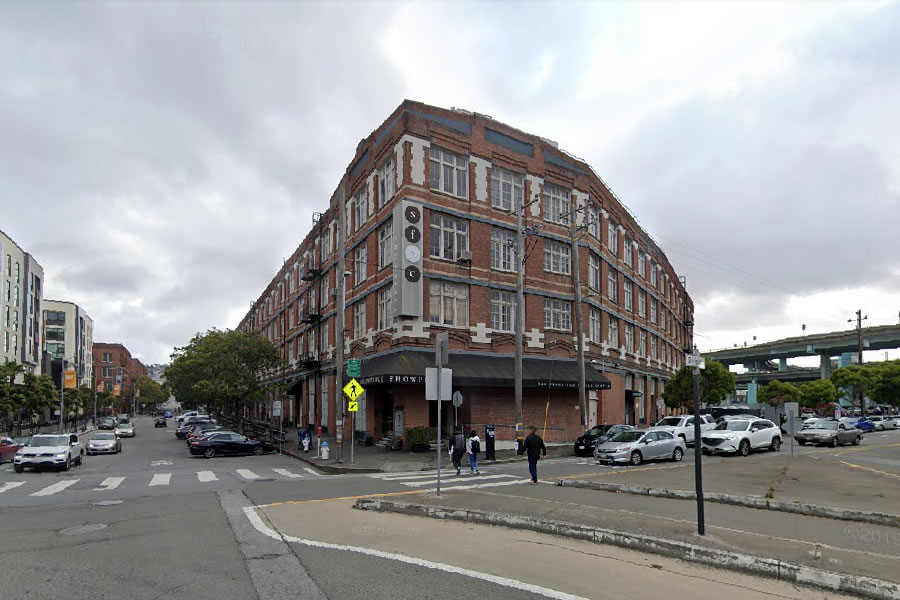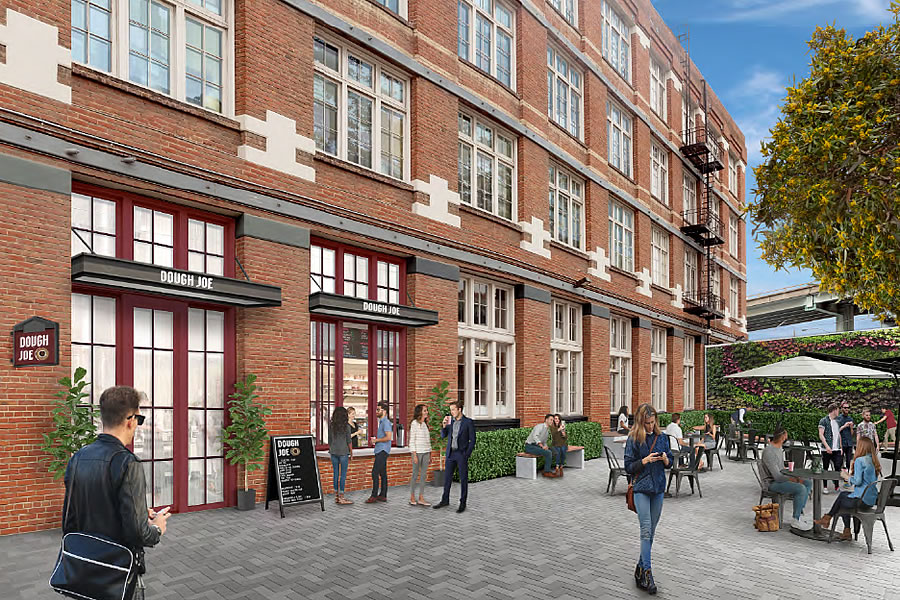While plans to convert the (newly) landmarked San Francisco Design Center building at 2 Henry Adams into tech space and lease the building to Pinterest were thwarted back in 2014, resulting in a Planning Code amendment to limit such wholesale conversions, new plans for a partial conversion of the building have been drawn.
If approved next week, the top floor of the Design Center will be converted into 49,364 of general office space, with 15,701 square feet of renovated “PDR” space as well.
In addition, the historic building’s shell is slated to be rehabilitated, along with its core. And the unpaved triangular portion of the building’s parcel fronting Division Street, which is currently used for Design Center parking, is slated to become a pedestrian plaza.


Will this partial conversion morph over time into a wholesale conversion of the building? As in the owners come back in two years and seek to convert the third floor to office use? If that is the case, partial conversion/wholesale conversion is a difference w/o a distinction. Might as well allow for a total upfront conversion of the building. That would be a more practical and honest approach.
It may be a pipe dream, but the entire interior design/furniture industry center in the Design District would be wise to consider a coordinated retreat /move further south. The economic forces are way too strong in their current location. This is an ecosystem industry where being co-located is ideal, especially for the customer.
What if the Cow Palace was somehow retrofitted as a multi-level mall? I’m not sure where the funding would come from (thus the pipe dream comment) but would be great to see a new, central hub for these businesses, and not a multi-decade fragmentation and dispersal as we’re seeing now.
I think the goal of some is to turn the Cow Palace area into housing. Honestly, I think being nearer to the central city where most design/architecture firms and their clients are is a good thing. But would be better if there was also a ton more housing and restaurants nearby to keep the showrooms busy all week/end.
The proposed conversion is <50K square feet and qualifies for Prop M under the "small projects" category. Conversions for more than 50,000 square feet have to compete in the general category for Prop M allocations, which would likely take much longer.
Restoration Hardware was/is building a flagship showroom at Pier 70 and I was hoping the whole design district would follow them out there.
The current neighborhood (I work in a showroom) is being slowly taken over by tech. Most tech workers don’t come out of their caves to eat or shop here.
The vast majority of materials that adorn all those cute restaurants, boutique hotels, refurbished victorians, and fancy offices that accompany the tech industry in SF come from the Design District. Designers go there to see what’s new, talk shop, collect samples, get ideas, and BUY THINGS. Its a fairly profitable business under normal circumstances, but in this town even this business must be sacrificed for offices for useless app developers that do nothing but lose money. It’s craazy!
So true.
And what money comprises all the demand for those cute restaurants, boutique hotels, etcetera? Technology companies are among the most profitable businesses on the planet. The idea that they’re trivial or uneconomic places the poster squarely in the last century.
The Design district has been there for decades, chugging along selling materials for all the other industries that came before tech. The difference here is that tech is driving everything else out. When large numbers of those (yes, useless) tech companies crash and burn, we’ll be left with empty offices that used to be useful businesses. To say that this means I’m from the last century just makes you a pompous jerk. Now, go check your WeWork stock.
WeWork is a private company, so the comment is silly even if I get your attempt to gripe at the other poster.
In many ways, the term “tech” means very little in contemporary times, since most companies could be described as “tech” in some aspect or another. If you mean Big Tech, they aren’t going anywhere and they now touch most aspects of the economy. As for companies getting priced out of SF, the voters of San Francisco can thank themselves for that.
Proposition M, passed way back in 1986, has created an artificial office space limit that resulted in, at times, the most expensive office space in the nation, and some of the most expensive commercial space in the world, ensuring local small businesses and non-profits can not afford it. And, when even big corporations like McKessen and Schwab decide San Francisco is too expensive, that leaves the only tenants with the money and desire to keep leasing space, Big Tech.
The new ballot measure in March would even further limit office development, which will ensure more companies continue to get prices out as soon as their leases are up and technology companies swoop in to take up the ever more precious office space. You wanted a “tech” town (even if you think you didn’t), and you got it.
I don’t think ‘Rstr”s comment is “silly” as much as it makes a point that’s perhaps a little too subtle for people to understand: the reason WeWork ISN’T a public company – i.e. their IPO crashed-and-burned on the launch pad – is because they’re a good example of a “useless” tech company (of course some may argue they’re neither, but that’s nevertheless an argument…it doesn’t make the initial remark frivolous).
Prop M – the culmination of an effort that goes back to (at least) the 1960’s – when large, boxy buildings appeared ‘en masse’ – was never specifically about making office space affordable so it seems dubious to scapegoat it – at least entirely – for high rents. Of course it doesn’t take a degree in economics to realize it had unintended consequences – having such a degree, I can tell you one in history, poly sci or even psychology would work just as well – but the same thing can be said for allowing unrestricted development.
I’m still waiting for a coherent argument for how becoming a tech hub has benefited the average resident of SF, whether one takes that to mean the city, specifically, or the area, generally. That they “aren’t going anywhere” doesn’t make them any more likable … it probably make them less so.
I would say that becoming a tech hub has financially benefitted everyone who owned property in SF circa 1996.
Have its effects on the city been otherwise good? You’re never going to get everyone to agree.
First, there is nothing subtle about WeWork’s failure, nor is it the example you and “Rstr” seem to think it is. It is a poorly managed company that was greatly overvalued. But, it is NOT a good example of a “useless” tech company because it is not, in fact, a “tech” company. It is a real estate company, which offers a tangible and much needed product. WeWork leases commercial real estate to companies and individuals who need office space. The profitable and public company IWG PLC, more commonly known as Regus, does pretty much the exact thing as WeWork, but it does it successfully and without pretending to be a “tech” company.
Second, you are making a straw man argument in your comment about Proposition M. Neither myself, nor anyone else, has ever claimed that Proposition M was about making commercial office space more affordable. The primary reason for its passage was to make HOUSING in San Francisco more affordable based on the argument that excessive commercial office development was the cause of escalating housing prices. And, at least based on how housing prices have ended up since it passage, it seems to have done a lousy job of fixing the problem it was intended to help solve. My comment about commercial rents soaring after its passage were meant to highlight Prop. M’s unintended and serious consequences, including the serious consequence of pricing out most other businesses in San Francisco and causing a situation where ONLY Big Tech or high flying startups with deep pocket investors can afford to rent office space in the city.
I was not trying to make an argument, “coherent” or otherwise, that SF’s status has a “tech hub” has benefited the “average resident.” (Though, one might ask which criteria are you using to define the “average resident.”) Nonetheless, as the city government and voters continue to implement policies with unintended consequences, such as Proposition M, which drive up the costs for everyone so that only Big Tech companies and their workers can afford to be in San Francisco, the “average resident” will one day be a Big Tech worker, and when that day comes, it will be pretty simple to show how SF becoming a “tech hub” has benefited them (i.e. by giving them employment).
But but…there is synergy. I need $10 million in venture capital for my ap that allows people to see what a couch will look like in my living room!
Once the Design District is gone, they’ll need that app to see the couches that used to be there!
I was recently in the Pacific Design Center in West Hollywood and there are quite a few vacant showrooms there, particularly on the upper floors. And the LA design market dwarfs the market here. Unfortunately, , not surprising some space may be re-purposed.